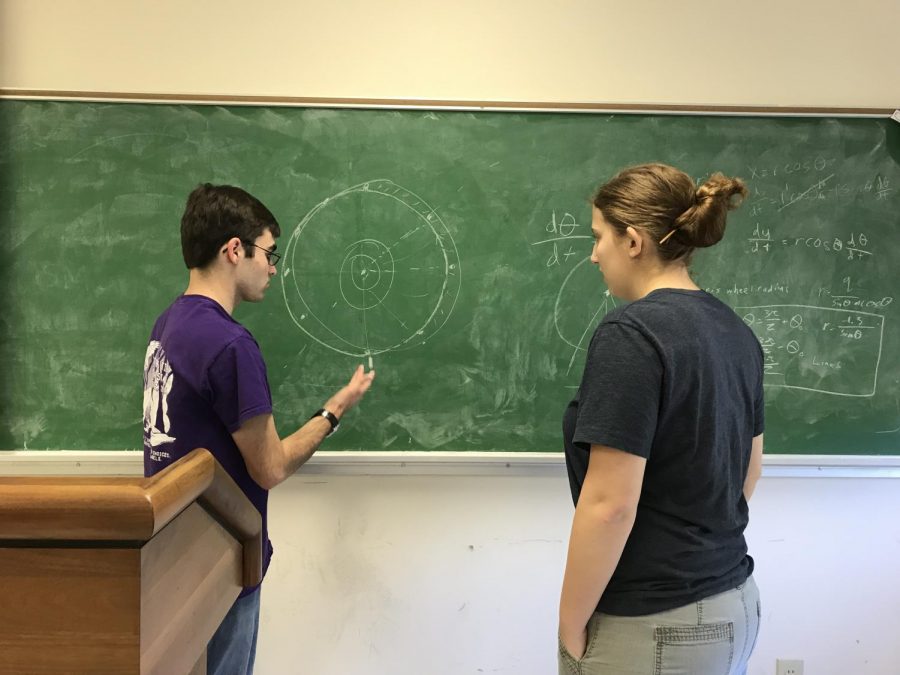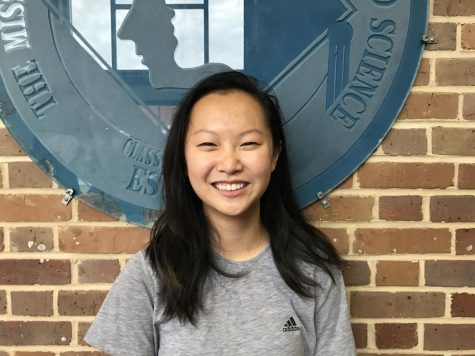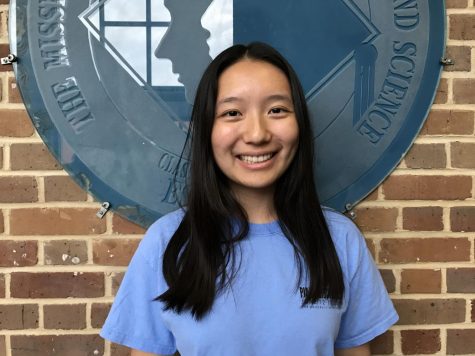Mathletes Round it Off During 36-hour Math Competition
William Johnson and Leah Pettit plan up a storm on the chalkboard.
November 13, 2017
On the fateful fall day of Friday, Nov. 10, ten MSMS mathletes arrived at Hooper at 8:00 a.m. sharp to begin the first hour of the 36-hour long math modeling competition. While barely an hour of math is pure torture for a typical student, leave it to MSMS student participants to spend 36-hours straight doing math.
The High School Mathematics Contest in Modeling, otherwise known as HiMCM, is a 36-hour competition where a group of up to four students write a potentially 30-page report addressing one of the two given problems. Any inanimate sources, such as past research paper or articles, could be used to help solve these problems as long as they referenced it.
“Students use their knowledge and creativity to solve large, complex problems and write a technical paper about their results in 36 hours,” said teacher sponsor Dr. Phillip Benge. “It was interesting to watch how the students attacked the problem. All teams at MSMS chose the same problem, however they approached and solved the problem in their own unique way. ”
While one may assume that this contest is your fill-in-the-blank or multiple-choice math test, HiMCM actually uses real-world situations that highlight math’s applicability to, daresay, make it more interesting.
“Having spent the last four or so years preparing for test style competitions was definitely a huge paradigm shift,” junior Hamilton Wan stated, “but I did enjoy it.”
“The problem that we chose was about designing an aerial light show,” stated senior Gary Nguyen. “I’ve never really thought about how managers put together an entertaining drone light show, so it was definitely a fun learning experience.”
MSMS also participated in HiMCM last year, and some students had mixed feelings about it.
“I hated it,” senior Kevin Liao definitively expressed after reflecting on last year’s experience.
This year, the feelings of exhaustion haven’t changed much.
Two hours into competition, junior Victoria Gong reported, “I think half of us have already given up… We are solving related rates of change with a squeaky piece of chalk.”
“It was very challenging. Compared to other math competitions, it was much longer and a lot more torturous,” Gong concluded after the competition. Gong added, “Dr. Benge will have our heads once he reads this paper.”
Other students, however, had a more positive view on it.
“Last year we went into the competition primarily excited over the thought of getting to sleep overnight in Hooper,” Nguyen reflected. “But this year, we made sure to be a little more prepared.”
Even Wan, who was four hours away touring with Sites and Sounds, showed pure dedication by communicating with his group through constant video calls using Google Hangouts.
“It was fun,” Wan expressed. “It kind of gave me a headache and it was definitely hard to work via Google Hangouts 200 miles away from the rest of my team, but I enjoyed it.”
Despite mixed feelings of exhaustion and excitement, participating students Victoria Gong, William Johnson, Leah Pettit, Conner Chitmon, Lori Feng, Hamilton Wan, Gary Nguyen, Michelle Luo, Peter Nguyen, Danail Dimitrov, Caitlyn Jordan and Noah Hinton all successfully survived a day and a half of pure math.











Jason • Mar 1, 2021 at 11:44 pm
Math competitions are always a great training for students. I believe that practice makes perfect, especially Math. Math is easy to learn because of the logic. Students can also train their logical thinking as well. I always let my son to take as much math work as possible that includes math competitions. So I find him a lot of math material via Beestar, which is an online platform that provides comprehensive math content to all level students.
Barbara Bugg • Nov 18, 2017 at 12:40 pm
It is dangerous for teenagers to go 36 hours without sleep. There is a good reason that our bodies have a natural sleep-wake rhythm.
Certain brain issues like bipolar and anxiety disorders are exacerbated by a lack of sleep. For many people, the event which precedes initial diagnosis is just one night without sleep.
I think it is irresponsible for the faculty to hild a 36 hour event without researching its possible effects on students. I’m sure that peer pressure leads to student participation regardless of the reluctance to stay up way too long.
I’m a biochemist whose son is a transportation engineer MSMS alum.
Zach Dicks • Nov 20, 2017 at 12:05 pm
Hi Barbara.
I agree with everything you said regarding the value of sleep.
I participated in this event back in 2004. We definitely slept during those 36 hours.
The experience was essentially receiving a problem Friday morning and presenting your work Saturday night as a team.
Our final product would have suffered had we not slept. It was essential to keeping team morale up and our brains high functioning, for the reasons you stated. It’s been a dozen or so years, but I think faculty made it clear we needed to sleep and be responsible to our bodies.
Helen Peng • Nov 27, 2017 at 11:02 am
Sleep is undoubtedly essential for our bodies. To clarify, however, most students who participated in HiMCM did sleep as needed. Essentially, the 36 hours served as the time limit for teams to submit their responses. Although they were technically given the option to stay awake during these hours, most students were encouraged to rest and eat in order to keep their energy throughout the competiton.